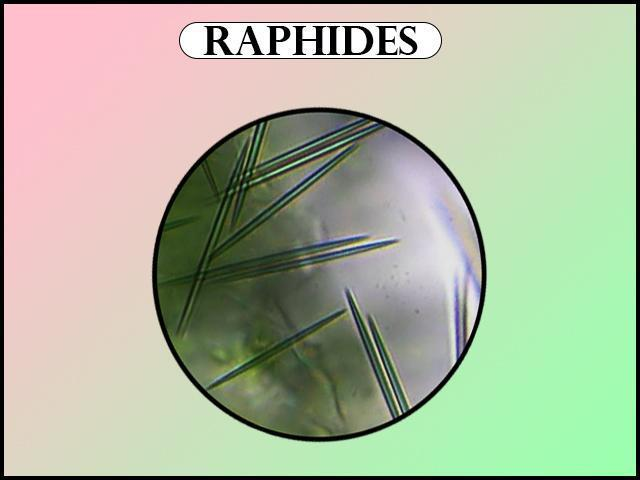
Answer
455.7k+ views
Hint: Raphides are commonly found in monocot families. One such genus of flowering plants showing raphides is seen in the family Araceae. Plants belonging to this genus are native to South-Eastern Asia and the Indian subcontinent.
Complete step by step answer:
Raphides are found in Colocasia, which is a monocot. Let's begin the explanation by understanding what raphides are. Raphides are needle-shaped crystals of calcium oxalate monohydrate. They can also be made up of calcium carbonate like aragonite. They can be seen in more than 200 families of plants. Some examples include Actinidia (Kiwifruit) , Colocasia (Cocoyam) , Monstera (Swiss cheese plant) etc.

So, the correct answer is ‘Colocasia’.
Additional Information:
- Raphides seem to be a defence reaction against plant predators, as they're likely to tear and harm the soft tissues of the throat or oesophagus of a plant predator chewing on the plant's leaves.
- The venomous process is of two stages - mechanical pricking and injection of harmful protease.
- Ingestion of a plant containing raphides, for example, certain house plants can typically cause immediate numbing. This is shortly followed by painful oedema, vesicle formation and dysphagia.
- Raphides can be destroyed in an acidic environment or chemical solvents like ether, but not by simple boiling.
- Plants that have large amounts of raphides are acrid and unpalatable in general.
Notes:
- Raphides are present in highly specialised cells called idioblasts. If consumed in high quantities raphides can lead to kidney stones.
- Druses are similar to raphides. However, they differ in the way that raphides are needle- shaped, whereas druses are globular or star- shaped.
- Citrus plants have thorns on their body as a defence mechanism. Citrus fruits show several important pharmaceutical functions such as antimicrobial, anti-inflammatory and anticarcinogenic activities.
Complete step by step answer:
Raphides are found in Colocasia, which is a monocot. Let's begin the explanation by understanding what raphides are. Raphides are needle-shaped crystals of calcium oxalate monohydrate. They can also be made up of calcium carbonate like aragonite. They can be seen in more than 200 families of plants. Some examples include Actinidia (Kiwifruit) , Colocasia (Cocoyam) , Monstera (Swiss cheese plant) etc.

So, the correct answer is ‘Colocasia’.
Additional Information:
- Raphides seem to be a defence reaction against plant predators, as they're likely to tear and harm the soft tissues of the throat or oesophagus of a plant predator chewing on the plant's leaves.
- The venomous process is of two stages - mechanical pricking and injection of harmful protease.
- Ingestion of a plant containing raphides, for example, certain house plants can typically cause immediate numbing. This is shortly followed by painful oedema, vesicle formation and dysphagia.
- Raphides can be destroyed in an acidic environment or chemical solvents like ether, but not by simple boiling.
- Plants that have large amounts of raphides are acrid and unpalatable in general.
Notes:
- Raphides are present in highly specialised cells called idioblasts. If consumed in high quantities raphides can lead to kidney stones.
- Druses are similar to raphides. However, they differ in the way that raphides are needle- shaped, whereas druses are globular or star- shaped.
- Citrus plants have thorns on their body as a defence mechanism. Citrus fruits show several important pharmaceutical functions such as antimicrobial, anti-inflammatory and anticarcinogenic activities.
Recently Updated Pages
Who among the following was the religious guru of class 7 social science CBSE

what is the correct chronological order of the following class 10 social science CBSE

Which of the following was not the actual cause for class 10 social science CBSE

Which of the following statements is not correct A class 10 social science CBSE

Which of the following leaders was not present in the class 10 social science CBSE

Garampani Sanctuary is located at A Diphu Assam B Gangtok class 10 social science CBSE

Trending doubts
A rainbow has circular shape because A The earth is class 11 physics CBSE

Fill the blanks with the suitable prepositions 1 The class 9 english CBSE

Which are the Top 10 Largest Countries of the World?

How do you graph the function fx 4x class 9 maths CBSE

The Constitution of India was adopted on A 26 November class 10 social science CBSE

Give 10 examples for herbs , shrubs , climbers , creepers

Difference between Prokaryotic cell and Eukaryotic class 11 biology CBSE

The Equation xxx + 2 is Satisfied when x is Equal to Class 10 Maths

Change the following sentences into negative and interrogative class 10 english CBSE




